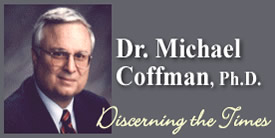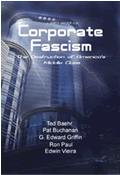UNIONS, PROTESTS AND
THE COLLAPSE OF THE U.S. ECONOMY
PART 1
By
Dr. Michael S. Coffman Ph. D.
April 9, 2011
NewsWithViews.com
During the February/March Wisconsin Public Union Debacle the union workers were portrayed by the mainstream press as underpaid, overworked public workers who were having their bargaining “civil rights” unjustly attacked by Republicans bent on destroying the Union. The truth, however, paints a very different and dangerous picture that threatens the very foundations of America.
It used to be that public sector unions were shunned even by progressives. President Franklin Roosevelt, a strong friend to unions, warned in 1937, “The process of collective bargaining, as usually understood, cannot be transplanted into the public service.” The reason for his concern? “[A] strike of public employees manifests nothing less than intent on their part to obstruct the operations of government until their demands are satisfied. Such action looking toward the paralysis of government by those who have sworn to support it is unthinkable and intolerable.” Roosevelt’s fears are literally coming true today.
Roosevelt wasn’t the only one warning that public employees should not be unionized. George Meany, the first president of the AFL/CIO remarked in 1955, it was "impossible to bargain collectively with the government." But starting with Wisconsin in 1959, states began to allow collective bargaining in government. Again the AFL/CIO warned; “in terms of accepted collective bargaining procedures, government workers have no right beyond the authority to petition Congress—a right available to every citizen.” It wasn’t until Democrat progressives realized that public sector unions would give the Democrats and progressives millions of campaign dollars and votes in any election did progressives begin to clamor for the right of public employees to unionize.
Public sector unionization provides the perfect circle of corruption. Once public employees were unionized, progressive Democrats could promise union members the moon to get their votes and campaign contributions. Once in office, there was no incentive for the elected official to protect the taxpayer when bargaining with the union. After all, to progressives, the taxpayer is merely a faceless, bottomless pit of tax revenue. Conversely, politicians have every incentive to capitulate to the unions to get their vote and campaign funding in the next election. In effect, public unions help elect the very politicians who will act as "management" in their contract negotiations. In essence, unions can handpick the officials who will sit across from them at the bargaining table.
A private corporation cannot do this. They must be tough, or their labor costs will become so high they will go out of business. Collective-bargaining laws also gave government workers a powerful incentive to join unions. The portion of full-time unionized public employees jumped from 10% to 36% of the public-sector work force between 1960 and 1980.
Today, the American Federation of Teachers (AFT) has more than 1.5 million members. In comparison, the largest exclusively private-sector union, the United Food and Commercial Workers has a paltry 1.3 million members. As large as the AFT is, however, it is dwarfed by the largest labor union in the United States: the National Education Association (NEA), which claims 3.2 million members. The NEA also claims that in a single decade it became the most powerful union in the nation.
Although highly variable, public unions have generally given their members incredible retirement benefits. For example, the California Correctional Peace Officers Association successfully negotiated a contract with California in 2006 giving the average union member $70,000 a year, and more than $100,000 with overtime. Corrections officers can also retire with 90% of their salaries as early as age 50. These kinds of benefits are not universal, but they are not uncommon either.
Nationwide the Bureau of Labor Statistics at the U.S. Department of Labor (DOL), reported that private sector employees receive an average of $40,768, while public workers receive $54,933 annually in wages.
The DOL also reported that state and local government employees received benefits that were 69 percent higher than those in the private sector in 2010. State and local government employees earn $13.85 per hour in benefits compared to the private sector workers who earn an average of $8.20 per hour. The Cadillac benefit packages for state employees have resulted in unfunded pension liabilities from $1 to $2.8 trillion, according to StateBudgetSolutions.org. The National Center for Policy Analysis calculates an even higher unfunded pension liability for all states at $3.1 trillion.
Regardless, of the amount, it far exceeds the private sector and the individual state’s ability to sustain it. The cycle of corruption between progressives and public unions has been repeated time and time again until the public sector unfunded benefit packages now threaten to bankrupt the states. Hence, states across the country suffering this corruption must take direct aim at public employee unions and their grossly out-of-line pension benefits.
Certainly, not all states have fallen victim to the public union corruption cycle. The public employees and teacher salaries and benefits are in line with the private sector. However, many of these states are also suffering from staggering unfunded liabilities because past progressive-dominated legislatures and governors have raided or not contributed their share to retirement funds. These progressives needed to pay for their altruistic social programs and they got it from retirement funds. The money is gone now, leaving the current legislature and governor (usually Republican) the nightmare of trying to bring the state back from bankruptcy to solvency without being blamed for the nightmare.
Once it became apparent that the corruption caused by the past cozy relationship between unions and progressive politician is threatening state solvency, taxpayers are outraged. Last November candidates who promised fiscal responsibility were sent by the voters en masse to Congress, state legislatures and governor offices to fix the insolvency mess. However, fixing the mess is easier said than done. As soon as the Republicans try to apply fiscal responsibility, the unions scream their civil rights are being violated. They protest loudly, sometimes violently and generally claim they are due every dime they make.
Other than a willingness to make small concessions, unions so distort the facts that they make it sound as if the taxpayers are ripping off underpaid public workers. Tragically, their tactics are working. Millions of dollars in union sponsored attack ads are convincing voters that the Republicans are mean and are trying to destroy the unions when in fact they are trying to save their respective states.
New Jersey, Illinois and Wisconsin
Some states like Indiana addressed the pension/collective bargaining issue several years ago and are generally in good fiscal condition today. New Jersey Governor Chris Christie was the first governor to take on the unions following the November 2010 Republican Revolution. New Jersey was $11 billion in the red and getting worse every day.
On his first day in office Christie signed an executive order preventing state employee unions from making political contributions. That broke the union/politician corruption cycle that kept New Jersey’s public union’s fat and progressives in power. Christie also battled the teacher’s unions by preventing pay raises in 2010 and lifetime health benefits for the union’s members. He also asked for a one year freeze on salaries, changes in the pension rules to limit future benefits and for the employees to pay a tiny fraction of their salaries to help cover the costs of their health insurance.
Christie’s proposals met with a firestorm of condemnation from the unions. Politicians who lost most of their campaign contributions under Christie’s executive order also joined the chorus of vitriol. The unions alone spent over $6 million in attack ads against Christie. Christie stood his ground and retorted, "If we don't win this fight, there's no other fight left." He was correct. Without his changes, the state would soon be in bankruptcy. Ironically, many of the public employees would have $0 salaries and benefits because of layoffs, while others would be forced to take severe salary and benefit reductions.
Unions never see it that way, however. Invariably, they accuse the state of hiding money or not prioritizing budgets to allow public employees what they deserve. Even though their toes are hanging off the edge of the bankruptcy cliff, they refuse to acknowledge it and continue to demand more. This bizarre refusal to accept reality is one of the reasons the private sector unions have lost so many members. It would have closed the doors of GM forever, if President Obama hadn’t bailed GM out and paid the union off with taxpayer money.
Unlike New Jersey, Illinois (surprise, surprise) voted the progressives back into power in 2010. The unions convinced the reelected progressive legislature that they should raise taxes by a whopping 66 percent to cover the $13 billion deficit it faces in 2011. Thirteen billion dollars is half of the state’s $26 billion budget! Raising taxes is the standard progressive solution to fiscal ills in the public sector. However, most analysts warn the tax increase will backfire and can possibly even reduce total tax revenues as businesses close and workers lose their jobs.
The comparison between New Jersey and Illinois will provide the perfect test of tea party vs. progressive economic theory. Worse, the Illinois solution merely kicks the can down the road as the state faces exponentially increasing deficits in the future. The root problem of the shortfall is not addressed with radical increases in taxes. The root problem centers on the grossly overpaid public employees receiving unconscionable benefits. These costs are rising exponentially as more and more people retire with the bloated benefits.
Governor Scott Walker and his Republican majorities in Wisconsin’s legislature were next state on the firing line. They had to reconcile a $137 million shortfall in 2011 and a $3.6 billion deficit in their two year 2012-2013 budget cycle. The 2011 hole could be filled if the public unions agreed to pay a 5.8 percent of their salary towards their pension fund, and 12.6 percent of their health care package. This is still less than most public employees have to pay in other states. However, after failing in New Jersey, the unions capitulated and agreed to the terms – temporarily.
While the agreement solved the immediate deficit, the root problem was the corrupt nature of collective bargaining in the public sector. As Wisconsin’s 2011 to 2012-13 huge increase in deficits illustrated, the deficit problem was going through the roof in the future. If the future excessive pension benefits were not stopped they would bankrupt Wisconsin within a few years, even with higher taxes and employee contributions. In other words, like New Jersey, the union’s demands were not sustainable.
Walker not only asked for employee contributions and some other give-backs, he asked for a severe reduction in the collective bargaining power of the unions. The Republican majority in both houses of the legislature agreed, and wrote legislation that would increase employee contributions and eliminate almost all union bargaining rights on everything except salary. Additionally, the unions would also have to hold annual votes to stay organized and would be unable to force employees to pay dues. Without these concessions, Governor Walker said 1500 state employees would have to be laid off.
If Governor Christie’s actions provoked a firestorm, Governor Walker’s and the Wisconsin legislature’s actions resulted in war. Raucous protestors occupied the capital. Initially the protests were civil and teachers brought their primary and high school students into the capital building to protest. The students were allegedly brought to demonstrate “democracy” to them. Of course, there is no chance of students this young truly understanding what was happening or what was at stake, other than what the teachers told them. Some called this child abuse despicable.
The unions put up $3.4 million in attack ads against the governor and Republican legislators, crying that the governor and legislator were union busting, denying workers their “rights,” and destroying “democracy.” Fourteen democrat senators fled the state so there would not be a super majority to pass funding-related legislation in the state senate. It turned into a fiasco that was exploited by the union attack ads.
Again, as the debacle heated up, the mainstream media faithfully spun the story to support the unions. Conflicting reports on salaries and benefits were reported daily, raising so much smoke and confusion so that very few understood the real facts. That was by design. The unions had to confuse the public to get their support.
Stripping the smoke away showed Walker to be correct. According to the U.S. Bureau of Labor, Wisconsin state employees earned average salary and wages (not including benefits) of $51,305 annually compared to only $38,625 a year for private sector employees in Wisconsin. Interesting, local government employees earned $38,121 annually, about the same as private employees. This is not unusual for less populated states where local taxpayers are more in tune with what is happening locally.
Most of the media attention was focused on the tens of thousands of Wisconsin teachers. The Wisconsin Department of Public Instruction’s Statistical Information Center on School Staff and Salary Data shows the average school teacher/staff salary of $51,675 with $25,596 in fringe benefits for a total of $77,271. That does not include school administrators which have average salaries of $77,857 with benefits of $29,694.
The average public union employee salary in Wisconsin is about $13,000 higher than the private sector employee. Even when the fact that teachers have college degrees is considered, the salaries are way out of line with the private sector. Although no one would dispute that teachers need to earn a living wage, it is often forgotten that teachers only work about ten months out of the year. That is either a huge benefit no one else gets.
Although there are other considerations, Wisconsin teachers and public sector employees generally are paid a minimum of 25 percent more in salaries than the private sector employees who ultimately pay their salaries. Yet, the mainstream media continue to describe the union employees the poor underdogs in the crisis whose rights are being violated by the heartless Republicans.
The Unions eventually brought in union thugs from other states to ratchet up the protests. Governor Walker and the Republican’s in the legislature had repeated death threats. Union thugs protested on their lawns at home and threatened their families. Of course, that is never reported in the mainstream media.
The Republican legislature held firm against this intimidation. The governor and legislator finally removed the financial aspect of the legislation, which allowed them to vote with a simple majority. The union thugs went berserk, literally storming the capital building through windows and doors, pushing back security and doing millions of dollars of damage. Of course, the taxpayers get to pay for the repairs. This is nothing less than politics by thuggery.
After the legislature passed the bill to limit collective bargaining and Governor Scott Walker signed it, Dane County Judge MaryAnn Sumi issued a temporary restraining order blocking the law from taking effect. The stay was requested by Democrat Dane County District Attorney Ismael Ozanne. Ozanne’s lawsuit claimed the legislature acted without the 24-hour notice required by Rule 93 in Wisconsin’s open meeting law.
Republican’s accused Secretary of State Doug La Follette of delaying the publication of the law to allow the union’s to find a sympathetic judge to issue the restraining order on the newly passed law. The unions found what they were looking for in Judge Sumi. However, the non-partisan Legislative Clerk, Rob Marchant, backed up the Republicans by saying, “In special session, under Senate Rule 93, no advance notice is required other than posting on the legislative bulletin board.”
Wisconsin state case law also supports the Republicans. Both LTSB v State and Lafollette v Smith found that legislative rules are completely within the jurisdiction of the legislature. Courts may “not intermeddle in purely internal legislative proceedings.” In spite of these legal precedents, Judge Sumi’s ruling still stands.
The unions have mounted a multimillion dollar attack campaign to recall several of the vulnerable republican legislators and Governor Walker himself. It is working. The Milwaukee Journal Sentinel reported on March 5 that 54 percent of Wisconsinites disapprove of Walker’s performance while 43 percent approved. It is amazing how citizens can believe that massive budget woes brought on by progressive legislation can be corrected without an all-out battle in the legislature. Especially when the unions are involved.
| Subscribe to the NewsWithViews Daily News Alerts! |
So why are the unions battling Wisconsin and other states so hard? The answer centers on an incredible lust for power and a heinous agenda. Unions can’t afford to lose in Wisconsin, or it will begin a rapid unraveling of their power across the country. Little do teachers, firemen and policemen know that they are merely being used as useful idiots (to use Stalin’s vernacular) to that end. In the final analysis, it is total power and a new form of government that the unions want. Read Part II to learn more about this shocking radical agenda. For part two click below.
Click here for part -----> 2,
� 2011 Michael Coffman - All Rights Reserved










 Share
This Article
Share
This Article



